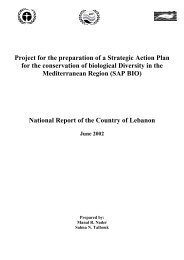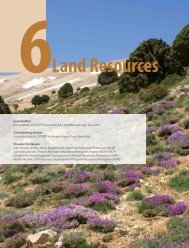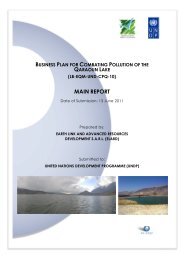Biodiversity and Forests
Biodiversity and Forests
Biodiversity and Forests
Create successful ePaper yourself
Turn your PDF publications into a flip-book with our unique Google optimized e-Paper software.
trend may continue for some years as there are<br />
still areas to be discovered <strong>and</strong> rediscovered. As<br />
is the case of the flora above, the herptiles of<br />
the Lebanese coastline are highly threatened<br />
by unregulated development <strong>and</strong> its skink <strong>and</strong><br />
snake species are in decline. In general, the<br />
herptiles of Lebanon are critically decreasing in<br />
<strong>and</strong> around cities, towns <strong>and</strong> villages. This is not<br />
only because of urbanisation <strong>and</strong> habitat loss<br />
but also because of the traditional persecution<br />
of these living organisms by local populations.<br />
However, the percentage of threatened reptile<br />
species is particularly high (18.2percent) <strong>and</strong><br />
expected to increase in the absence of a defined<br />
national strategy to conserve these species.<br />
Eirenis levantinus, reptile species threatened in Lebanon<br />
5.3.2 Freshwater <strong>Biodiversity</strong><br />
Lebanon’s freshwater fauna <strong>and</strong> flora include<br />
987 species (Al-Zein, 2001), of which 656 are<br />
invertebrate species (61 species of worms, 41<br />
mollusks, 60 crustaceans, <strong>and</strong> 494 insects; MOA,<br />
1996).The faunal species in freshwater represent<br />
16 percent of the total fauna biodiversity of<br />
the country <strong>and</strong> the floral species represent 6<br />
percent of the flora species only. Five percent of<br />
the country’s freshwater fauna are threatened,<br />
including the Globally Near Threatened Otter<br />
Lutra lutra, <strong>and</strong> 1.3 percent are endemic<br />
(MOA/UNEP/GEF, 1996). The only endemic<br />
freshwater fish to Lebanon Phoxinellus libani<br />
was considered extinct in the country (MOA/<br />
UNEP/GEF, 1996) but it has been observed at<br />
least in the Yammouneh Lake, Litani River <strong>and</strong><br />
Qaraoun Lake (El Zein, 2001). Many have been<br />
exterminated from specific river systems due to<br />
overfishing.<br />
There are 25 fish species pertaining to different<br />
families: Cyprinidae, Cyprinodontidae,<br />
Cobitidae, Salmonidae, Anguillidae, Cichlidae,<br />
Mugilidae, Puciliidae, Blenniidae, Lutjanidea.<br />
Of them, one species is listed as vulnerable,<br />
three are endangered <strong>and</strong> two are critically<br />
endangered. In addition to these, other species<br />
Credit: TERRE<br />
have been introduced for aquaculture: rainbow<br />
trout (Oncorhynchus mykiss) <strong>and</strong> brown trout<br />
(Salmotrutta fario; Al Zein, 1997), brook trout<br />
(Salvelinus fontinalis), common carp (Cyprinus<br />
carpio), mosquito fish (Gambusia affinis),<br />
silver carp (Hypophthalmichthys molitrix), etc.<br />
Whilst some were introduced for sports, other<br />
species were introduced to control different<br />
pest purposes, for example snails (Cyprinus<br />
carpio), mosquitoes (Gambusia affinis) <strong>and</strong> weed<br />
(Hypophthalmichthys molitrix). Because of low<br />
wild fishery yields <strong>and</strong> an abundance of pristine<br />
cold rivers <strong>and</strong> springs in Lebanon, small trout<br />
farms have sprouted throughout the country.<br />
Moreover, this aquaculture industry has grown<br />
significantly in recent years, especially after<br />
returning expatriates have introduced new<br />
ideas <strong>and</strong> new approaches to aquaculture from<br />
around the world.<br />
Trends. Freshwater biodiversity is being<br />
impacted particularly by disturbances affecting<br />
water sources <strong>and</strong> rivers which weaken<br />
freshwater ecosystems <strong>and</strong> result in the<br />
elimination of weak species especially those<br />
sensitive to pollution. Drainage, pollution <strong>and</strong><br />
human interference have drastically changed<br />
the fresh water ecosystem <strong>and</strong> resulted in a high<br />
proportion of endangered species whereas<br />
overfishing has caused the extermination<br />
of some fish species from certain rivers<br />
(MOE/UNDP, FNR-CBD, 2009).<br />
Freshwater stream in Kfarhelda (Batroun)<br />
Chapter 5: <strong>Biodiversity</strong> <strong>and</strong> <strong>Forests</strong> 157





